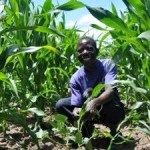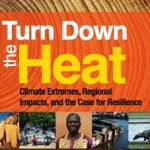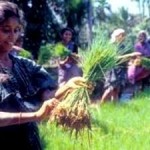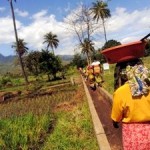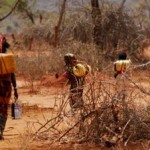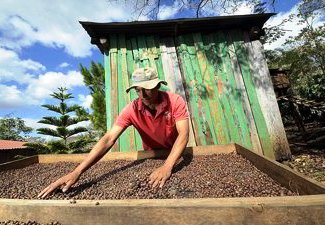
Bonn, Germany – Whether it’s swapping coffee for cocoa in Central America or bracing for drought in Sri Lanka with a return to ancient water storage systems, findings from a new report from the CGIAR Research Program on Climate Change, Agriculture and Food Security (CCAFS) chart a path for farmers to adapt to climate shifts despite uncertainties about what growing conditions will look like decades from now.
The study, “Addressing Uncertainty in Adaptation Planning for Agriculture”, which was published in the Proceedings of the National Academies of Sciences (PNAS), finds that the cloudy aspects of climate forecasts are no excuse for a paralysis in agriculture adaptation policies.
“Climate projections will always have a degree of uncertainty, but we need to stop using uncertainty as a rationale for inaction,” said Sonja Vermeulen, Head of Research at CCAFS and the lead author of the study. “Even when our knowledge is incomplete, we often have robust grounds for choosing best-bet adaptation actions and pathways, by building pragmatically on current capacities in agriculture and environmental management, and using projections to add detail and to test promising options against a range of scenarios.”
The CCAFS analysis shows how decision-makers can sift through the different gradients of scientific uncertainty to understand where there is, in fact, a general degree of consensus and then move to take action. Moreover, it encourages a broader approach to agriculture adaptation that looks beyond climate models to consider the socioeconomic conditions on the ground. These conditions, such as a particular farmer’s or community’s capacity to make the necessary farming changes, will determine whether a particular adaptation strategy is likely to succeed.
“Getting farmers, communities, governments, donors and other stakeholders to embrace various adaptation strategies can end up being equally or more important than seeking higher levels of scientific certainty from a climate model,” said Andy Challinor, a Professor at the Institute for Climate and Atmosphere Science, School of Earth and Environment at the University of Leeds, who co-leads research on climate adaptation at CCAFS and was also an author of the study. “There is no question that climate science is constantly improving,” he added. “But scientists also need to understand the broader processes involved in agriculture adaptation and consider how we can better communicate what we do know in ways that are relevant to a diverse audience.”
The CCAFS study uses examples from the program’s recent work in the developing world to illustrate how some countries have pursued climate change adaptation strategies that help them prepare for shifts in growing conditions in the near-term and long-term.
Some of the strategies involve relatively straightforward efforts to accommodate changes in the near-term that will present growing conditions that are not significantly different from what farmers have experienced in the past. For example, faced with climate models that predict above normal precipitation and others that predict it will be below normal, the Sri Lankan government is working with farmers to revisit traditional approaches to water storage to provide insurance against what, at the very least, will be climate variability.
The authors also explore how, in other parts of the world, adaptation planning must consider long-term changes that exceed historical experience and require “wholesale reconfigurations of livelihoods, diets, and the geography of farming and food systems”. For example, while various climate models offer different assessments of changes expected in Central America, they agree that over the long-term, higher temperatures are likely to render Arabica coffee production unsuitable at lower altitudes. “No regrets” strategies could involve shifting some production to higher altitudes and, at lower altitudes, switching to a different, but similarly lucrative crop, like cocoa.
Near-term Adaptation Planning in Sri Lanka: Ancient Water Storage Heads Off Future Threats
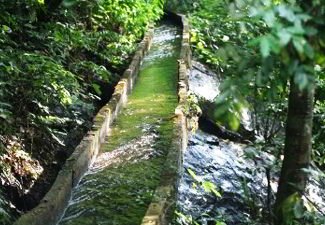
In Sri Lanka, agriculture accounts for almost one-third of employment and one-eighth of the gross domestic product (GDP). However, the sector faces uncertainly in the near-term as projections for precipitation and temperature vary dramatically. Instead of delaying a decision until more certainty emerges, government planners looked at the frequency of historical exposure to climate hazards (droughts, floods, cyclones, et. al.) and identified the need for improved water management as an agricultural adaptation strategy that would be beneficial regardless of how climate changes shaped the precipitation in the future.
The government then worked with smallholder farmers on a range of adaptive measures that have addressed agriculture water usage for centuries. Ancient Sri Lankan kingdoms used large above-ground tanks to collect and store rainwater for use in drier times; farmers implemented this solution with great success. Farmers also utilized systems that recycled their household wastewater and scaled back groundwater use to sustainable levels.
“In Sri Lanka, adapting without regrets started with knowing farmer capabilities and vulnerabilities,” noted Challinor. “Despite limited resources, the government’s adaptation plan is giving farmers a head-start because of its practical approach. Better water capture and management on the farms is translating to better preparation for more extreme weather conditions; better food security for the nation is the result.”
Long-term Adaptation in Nicaragua: Climate Change Brews a Dark Forecast for Coffee Farmers
In the mountains of Nicaragua, coffee constitutes roughly one-quarter of national agriculture revenues. Growing the popular Arabica coffee bean requires a very specific climate – between 19 to 22 degrees Celsius with little variation and ample rainfall.
While future climate scenarios for Nicaragua differ, scientists helped policy-makers see that all scenarios for 2030 and 2050 showed Arabica’s climate niche would be significantly affected. The zones suitable for the crop would move upwards to higher elevations, and in many places, the mountains would not be tall enough to host the crop in the future.
Rather than move three quarters of the current Arabica cropland, a shift that would mean disrupting the local ecosystem for new farmland, policymakers urged farmers to introduce new shade-grown coffee varieties or switch to cocoa – a crop identified as having similar cash value and suitable for future growing conditions.

